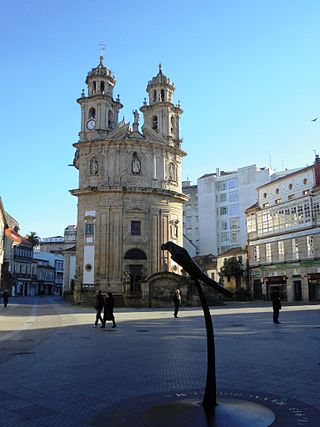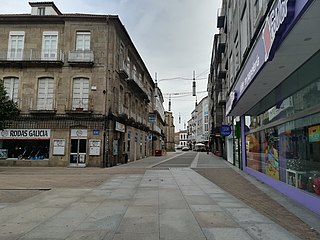
Pontevedra is a Spanish city in the north-west of the Iberian Peninsula. It is the capital of both the Comarca (County) and Province of Pontevedra, and of the Rías Baixas in Galicia. It is also the capital of its own municipality which is often considered an extension of the actual city.

The Monument to the Tertulia, known as the Literary Circle in Modern Coffee, is a sculptural group created by the Spanish sculptor César Lombera, in Pontevedra (Spain). It is located in Saint Joseph's Square in front of the Café Moderno and the central building of the former Provincial Savings Bank of Pontevedra and was inaugurated on 13 January 2006.

The Plaza de la Leña is a picturesque medieval square located in the heart of the old town of Pontevedra (Spain). It is the most typical medieval square in the historic centre and in Galicia.

The Gran Garaje is an Art Nouveau building dating from 1915, located in the city centre of Pontevedra, Spain.

The walls of Pontevedra were a fortification of the city of Pontevedra (Spain), which disappeared for the most part towards the end of the 19th century, although some remains are still visible, the most important being the crenellated section in Arzobispo Malvar Street. This complete section, approximately 40 metres long, can be accessed from the gardens of the two buildings on the west side of Santa María Avenue.

The former College of the Jesuits is an 18th century baroque building located in Sarmiento Street in the heart of the old town of Pontevedra, Spain. A secondary educational institution founded by the Jesuits in 1695, the building is known today as the Sarmiento Building and is one of the seats of the Pontevedra Museum.

The Plaza de Teucro is a square of medieval origin located in the heart of the old town of Pontevedra (Spain). It is the most harmoniously proportioned medieval square in the city.

Méndez Núñez Square is a square of medieval origin located in the heart of the historic centre of Pontevedra (Spain).

The historic centre of Pontevedra (Spain) is the oldest part of the city. It is the second most important old town in Galicia after Santiago de Compostela, and was declared a historic-artistic complex on 23 February 1951.

The Plaza de la Peregrina is an 18th century square located in the city centre of Pontevedra (Spain), on the edge of the historic centre.

The Castelao building is a modern architectural building from the beginning of the 21st century located on the corner of Padre Amoedo Carballo and Sierra Street in Pontevedra, Spain, on the edge of the historic centre. It belongs to the Pontevedra Museum.

The Pontevedra Bus Station is a bus station in Pontevedra (Spain) that allows inter-city bus traffic, with national or international destinations.

The calle Benito Corbal is a street in Pontevedra (Spain) located in the first urban expansion area of the city. It is one of the main streets of Pontevedra, known as the "Golden Mile".

The Calle García Camba is a street in Pontevedra (Spain) located in the city centre, in the first urban expansion area. It is one of the main streets of Pontevedra.

The Calle de la Oliva is a street in Pontevedra (Spain) located in the city centre, on the edge of the old town. It is one of the main streets of Pontevedra and one of the most commercial.

The Calle Michelena is a street in Pontevedra (Spain) located in the city centre, on the edge of the old town. It is one of the main streets of Pontevedra and one of the most commercial streets of the city.

The Calle General Gutiérrez Mellado is a pedestrian street in the Spanish city of Pontevedra, located in the first urban expansion zone. It is one of Pontevedra's main streets.

The Marquis of Riestra street is a central street in the Spanish city of Pontevedra, in the first expansion zone of the city in the 19th century, running longitudinally parallel to the Palm Trees Park on its eastern side. It is one of the main streets in Pontevedra city centre.

The Ensanche of Pontevedra is the neighbourhood that forms the centre of the Spanish city of Pontevedra, made up of several successive extensions to the city outside the old town. The term Ensanche means " widening " in Spanish and refers to the expanding areas of Spanish cities towards the end of the 19th century, when the demographic explosion and the industrial revolution led to the demolition of the old city walls and the construction of new areas outside the old fortified walls.

Calle Sarmiento is a street in the Spanish city of Pontevedra, located in the city's historic centre.























